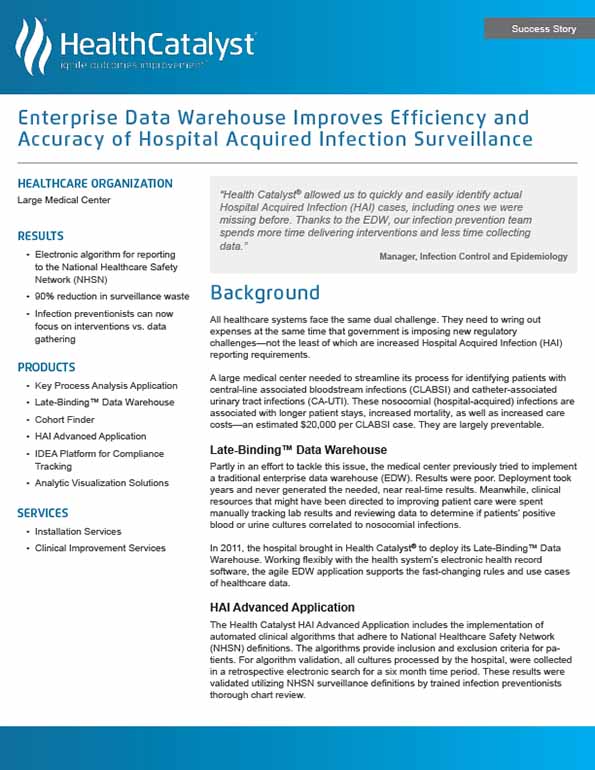Adopting an enterprise data warehouse had a number of positive affects for one medical center. Not only did they create way to more effectively discover and treat certain hospital-acquired infections, the organization also developed five steams of quality improvement—infectious disease, population health, cardiovascular, neuroscience and oncology.
“Health Catalyst allowed us to quickly and easily identify actual Hospital Acquired Infection (HAI) cases, including ones we were missing before. Thanks to the EDW, our infection prevention team spends more time delivering interventions and less time collecting data.”
- Manager, Infection Control and Epidemiology
All healthcare systems face the same dual challenge. They need to wring out expenses at the same time that government is imposing new regulatory challenges—not the least of which are increased Hospital Acquired Infection (HAI) reporting requirements.
A large medical center needed to streamline its process for identifying patients with central-line associated bloodstream infections (CLABSI) and catheter-associated urinary tract infections (CA-UTI). These nosocomial (hospital-acquired) infections are associated with longer patient stays, increased mortality, as well as increased care costs—an estimated $20,000 per CLABSI case. They are largely preventable.
Partly in an effort to tackle this issue, the medical center previously tried to implement a traditional enterprise data warehouse (EDW). Results were poor. Deployment took years and never generated the needed, near real-time results. Meanwhile, clinical resources that might have been directed to improving patient care were spent manually tracking lab results and reviewing data to determine if patients’ positive blood or urine cultures correlated to nosocomial infections.
In 2011, the hospital brought in Health Catalyst to deploy its Late-Binding™ Data Warehouse. Working flexibly with the health system’s electronic health record software, the agile EDW application supports the fast-changing rules and use cases of healthcare data.
The Health Catalyst HAI Advanced Application includes the implementation of automated clinical algorithms that adhere to National Healthcare Safety Network (NHSN) definitions. The algorithms provide inclusion and exclusion criteria for patients. For algorithm validation, all cultures processed by the hospital, were collected in a retrospective electronic search for a six month time period. These results were validated utilizing NHSN surveillance definitions by trained infection preventionists thorough chart review.
Within six months, chart reviews showed that use of the Health Catalyst Application delivered more accurate regulatory reporting of HAI rates with a 90% reduction in surveillance resources. In addition, Health Catalyst produced a near real-time reporting dashboard that displayed analytics in a highly visual, easy-to-interpret display.
The net effect is that infection preventionists now spend far more time focusing on education, clinical interventions and analysis versus surveillance waste. Over time these interventions should contribute to decreasing infection rates.
A multi-disciplinary team including infection preventionists, clinicians, technical, financial, quality and clinical improvement departments worked together to evaluate the hospital’s quality measures, identify HAI opportunities for improvement, revise the EDW’s algorithms, and to develop easy-to-understand visualizations. Past initiatives of this type tended to be of a temporary nature. Today this team meets on a monthly basis to ensure the clinical improvement gains are sustained and to evaluate opportunities for expansion into additional care process families such as septicemia.
The EDW’s impact is being felt well beyond HAI surveillance and improved detection rates. The medical center has developed five streams of quality improvement—infectious disease, population health, cardiovascular, neuroscience and oncology. The director of clinical and business analytics expects the EDW’s influence to spread as they deploy the Health Catalyst products and services to other clinical programs.
“We expect to see more meaningful impacts in the near future as we expand our Health Catalyst Clinical Improvement Services and Late-Binding™ Data Warehouse beyond the current five streams of work to include virtually every clinical area in the hospital.”
- Director of clinical and business analytics


